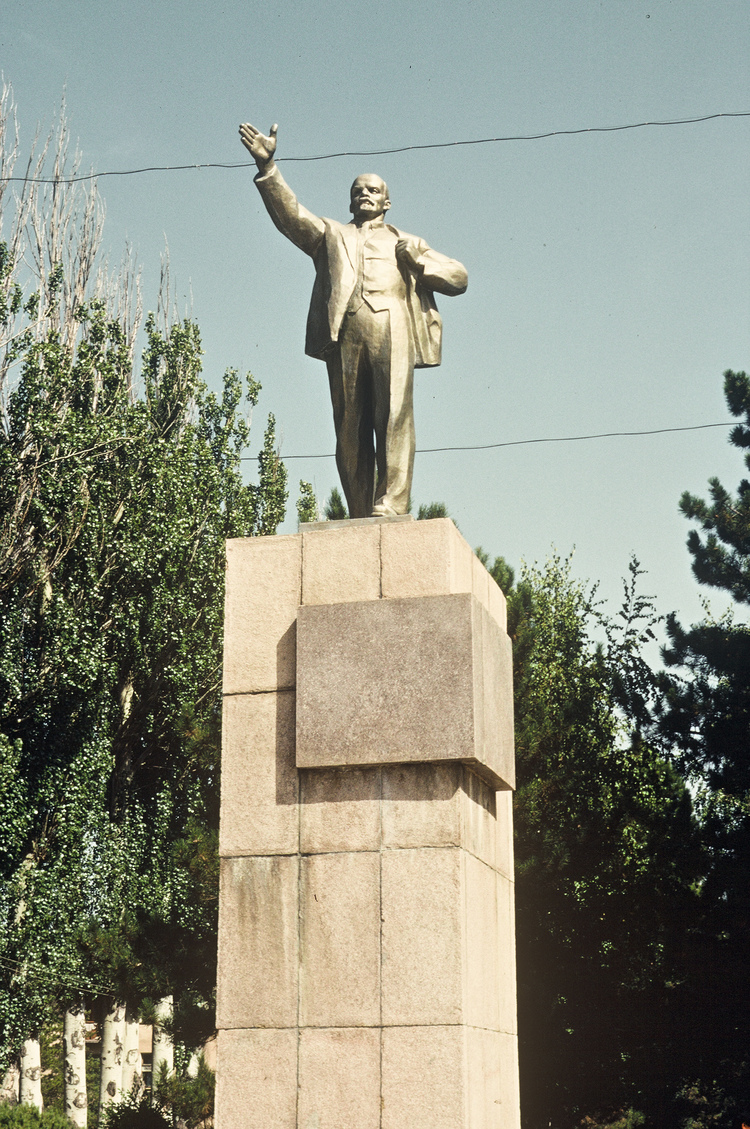“It’s faster than the Yak-40.” A fellow passenger at Bishkek’s Manas Airport pointed out of the departure lounge window towards the Kyrgyzstan Airlines aircraft on the tarmac, the first flight of the day to Osh. It was a Tupolev TU-134, which since the mid-1960s had been the standard short haul jet airliner in the Soviet Union and eastern Europe. It looked a little worn around the wingtips and tail, but I assumed it had been seeing its mechanic for regular check-ups. I hadn’t yet flown in the smaller Yak-40, the other plane on the main domestic route in Kyrgyzstan, but we passed a couple as we walked across the tarmac. The Yaks, with a light coat of snow on the wings and icicles hanging from the wheel housings, looked as if they would be happier sitting in a nice warm hangar than flying anywhere.
Postcards from Stanland: Journeys in Central Asia (Ohio University Press, 2016) is available from Amazon, Barnes & Noble, Books-a-Million and other online retailers. Read excerpts at www.davidhmould.com (Travel Blogs) or Facebook /PostcardsFromStanland/ or view readings and interviews on YouTube
I don’t know where the airport baggage handlers were on that cold December morning, but the passengers had to carry their luggage to the plane, where one of the ground crew hoisted bags into the hold. There was a lot of jostling for position. Several passengers had been on shopping trips to Moscow, Delhi and Bangkok to restock inventory for their shops or bazaar stalls, packing it in sheets or blankets secured by rope, or in cheap, plastic zipper bags that looked as if they would burst open at any moment. Nothing was weighed. Several passengers (myself included) were not aggressive enough and were left standing on the tarmac holding our bags. The crew member closed the hold, looked towards us, shrugged and shook his head, lit up a cigarette and sauntered back towards the terminal.
We walked up the steps to the aircraft carrying our bags. All the overhead compartments were full. My bag was small enough to fit in a bin behind the cockpit, but larger bags were stowed in the aisle. We took off 30 minutes late, and were soon over the snow-capped mountains of the Kyrgyz Ala Too. We crossed two more high ranges before descending into Osh and the Fergana Valley an hour later. I had not followed what appeared to be the brief safety announcement in Russian, so I rifled through the seat pocket, eventually finding an English-language booklet. It did not reassure me. “To escape through emergency hatch. Pull handle. Open hatch cover. Throw out rope free end into hatch.” I had no idea where the hatch was, and even if I did I didn’t think I could clamber over the mountain of luggage to reach it. And then I would have to find the “rope free end.”
The “foreigner’s price” for a one-way flight from Bishkek to Osh was about $80. Locals paid about $25. In theory, the “foreigner’s price” included perks. You got to wait in a separate terminal with an overpriced souvenir shop, and were escorted to the plane by an official. It was a legacy of Soviet times, when all foreigners were kept under surveillance and shepherded around in groups by Intourist, the official government travel agency. Somehow, Intourist survived the fall of the Soviet Union, and was still inconveniencing travelers in Kyrgyzstan in the mid-1990s. On the return trip to Bishkek three weeks later, the staff at Osh airport solemnly weighed my bags, charged me $14 for overweight, and told me that I could collect them from Intourist in Bishkek. “That means you’ll get them an hour later than everyone else,” a passenger told me. At Manas Airport, I lingered by the conveyor where other passengers were picking up their bags. Several of the rubber flaps that divided baggage claim from the loading area were missing. I peered through and saw my bags about to be loaded onto a hand cart to be consigned to the Intourist bureaucracy. “Moy bagaj,” I shouted, and held out a five-dollar bill. A hand came through the flaps and took the bill. The conveyor belt re-started and my bags came through.
Slow bus to Almaty airport
At the Hotel Dostuk in Bishkek, I paid the $60 foreigner’s price for a ticket on the 10:00 p.m. bus to Almaty airport, 150 miles across the border in Kazakhstan. I didn’t realize I was also a travel pioneer—this was the inaugural run for the airport service. The bus was brand new, and the driver was still apparently learning the controls because we spent several minutes parked outside the hotel while he tested the lights. The company evidently needed help in the marketing department, because I was the only passenger on a 48-seat bus. In addition to the driver, there was a hostess who served champagne and soft drinks from a cooler. We set off into the night, the driver trying to protect his vehicle by dodging the potholes and driving slowly over the speed bumps.
I knew we were in trouble when, on the outskirts of Almaty, the bus circled a roundabout twice before the driver tentatively selected an exit. We drove for another 45 minutes through darkened streets. At intersections, the driver slowed down and had hushed conversations with the hostess. Soon, the conversations became more animated. It was clear we were lost. There weren’t many people on the streets at 2:00 a.m. but eventually the driver found someone who gave him directions. When we reached the airport, more than an hour late, the driver was uncertain about maneuvering into a parking space. The hostess and I got out to watch the sides of the bus, shouting instructions. “Chu chu na lieva [a little to the left]. "Dostatochno [enough]!”









